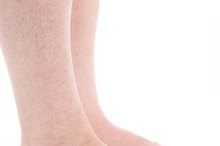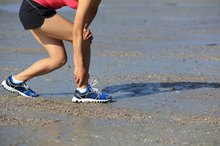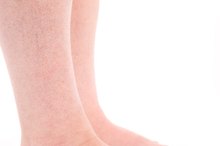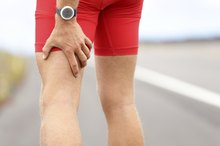Pain in the Quadriceps
Pain in your quadriceps can literally stop you in your tracks. These muscles are located at the front of your thighs and pain in them can indicate overuse or sports injury.
In rare cases pain in the quads can be due to a serious underlying medical condition. See your doctor if you have cramping or "charley horse" sensations along with a leg that is reddened, swollen and warm to the touch.
Read more: How to Tell if Your Quadriceps are Tight
Quadriceps Strain
With a quadriceps strain, muscle fibers are stretched or torn. The injury most often results from activities that require explosive leg movement, such as sprinting, jumping, kicking or performing intense leg presses.
A grade I injury is a mild strain in which muscle fibers are stretched, resulting in tenderness and soreness; grade II causes some tearing of fibers, loss of strength and mobility and mild swelling. With grade III, the muscle is ruptured, causing intense pain, swelling and discoloration.
Minor strains can be treated with the R.I.C.E. method: rest, icing the leg for 20 minutes every few hours; compression with an elastic bandage; and elevation. If you have severe pain or swelling, discoloration, difficulty walking, or heard a "pop" at the time of the injury, you should consult your doctor.
- With a quadriceps strain, muscle fibers are stretched or torn.
- With grade III, the muscle is ruptured, causing intense pain, swelling and discoloration.
Quadriceps Tendonitis
Hyperextension of the Calf
Learn More
Quadriceps tendonitis is the inflammation of the tendon that connects the quadriceps muscles to the knee and is common among active people. Symptoms include aching or burning pain — particularly when you move the knee — swelling around the knee where the quadriceps muscle attaches, and stiffness. Treat quadriceps tendonitis by resting from the activity that caused it and icing the affected area.
You can take over-the-counter anti-inflammatory medications for pain as long as you have no conditions precluding their use. Although mild cases of tendonitis can be treated at home, see your doctor if the pain interferes with daily activities for more than a few days, despite self-care.
- Quadriceps tendonitis is the inflammation of the tendon that connects the quadriceps muscles to the knee and is common among active people.
- Although mild cases of tendonitis can be treated at home, see your doctor if the pain interferes with daily activities for more than a few days, despite self-care.
Delayed Onset Muscle Soreness
Simple muscle soreness can strike several days after a taxing workout. If you did a heavy lifting session that isolated the quads with lots of squats and extensions, you may not feel the soreness and pain for as long as 72 post workout. Another cause of seriously sore quads is repetitive eccentric, or lengthening, contractions of these muscles. A downhill run or hike could be the culprit.
Once thought to be due to a buildup of lactic acid, this delayed onset muscle soreness, or DOMS, is due to micro tears in the muscle fibers. DOMS resolves within a few days. Icing, gentle massage, foam rolling, epsom salt baths and light physical activity helps speed up the healing process.
Read more: Stretches for Tight Quads
- Simple muscle soreness can strike several days after a taxing workout.
- Another cause of seriously sore quads is repetitive eccentric, or lengthening, contractions of these muscles.
Claudication
Dull Aches in the Shin
Learn More
Claudication, often a symptom of peripheral artery disease, is a painful circulatory disorder. Usually noticeable while exercising, as the condition progresses it can also affect you while you're at rest. The primary symptom is aching or burning pain in your legs or arms.
Severe claudication can cause bluish toes that are cold to the touch; you also might develop sores. Your doctor can diagnose claudication by checking the blood pressure in your ankles and arms; sometimes, ultrasound and MRI are used. Claudication is treated with aspirin, statin drugs and anticoagulants. Surgery is sometimes required.
- Claudication, often a symptom of peripheral artery disease, is a painful circulatory disorder.
- Severe claudication can cause bluish toes that are cold to the touch; you also might develop sores.
Related Articles
References
Writer Bio
Carol Sarao is an entertainment and lifestyle writer whose articles have appeared in Atlantic City Weekly, The Women's Newspaper of Princeton, and New Millennium Writings. She has interviewed and reviewed many national recording acts, among them Everclear, Live, and Alice Cooper, and received her Master of Fine Arts degree in writing from Warren Wilson College.









